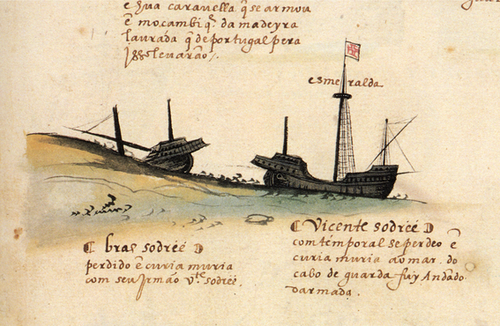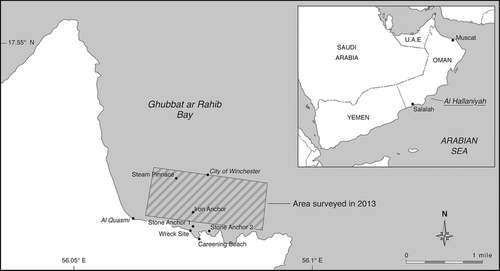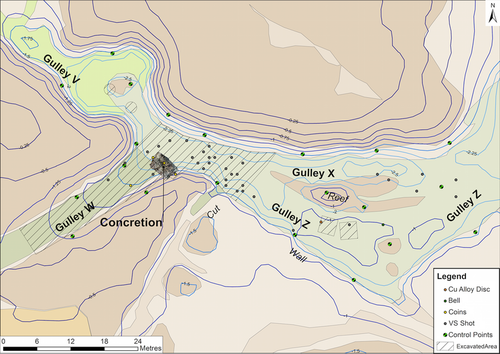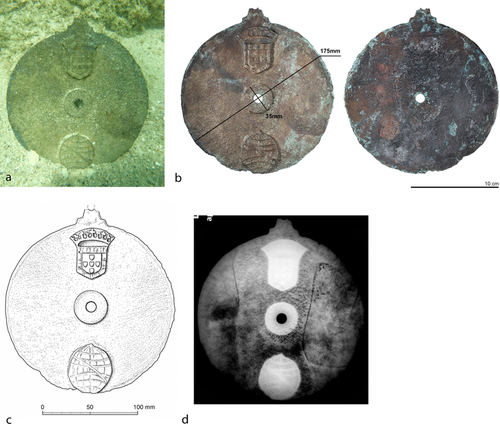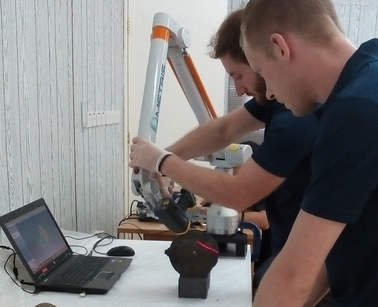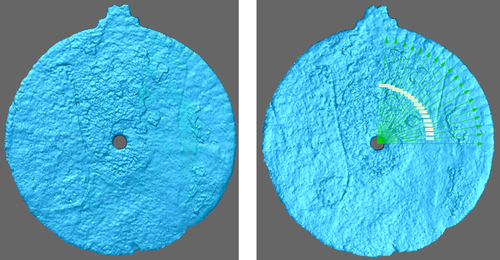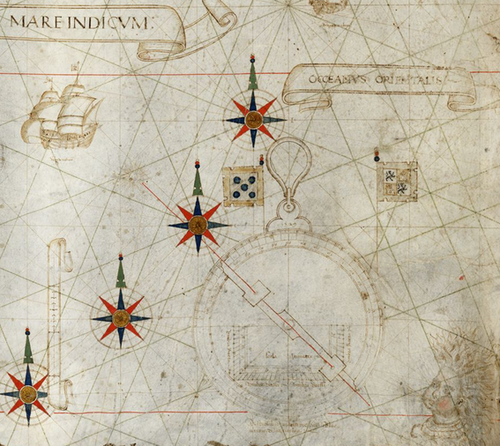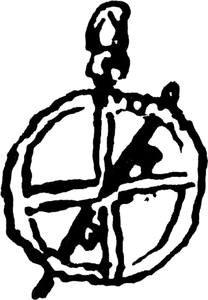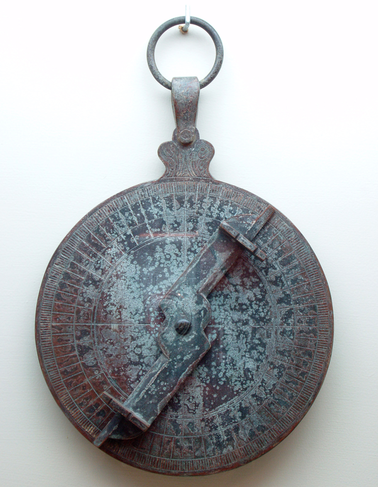Abstract
A unique leaded‐gunmetal disc decorated with iconic Portuguese markings was recovered in 2014 during archaeological excavations at the Sodré shipwreck site in Al Hallaniyah, Oman. Initially the identity and function of the disc was unknown, although it did possess characteristics suggesting it could be an astrolabe. Laser imaging of the disc post conservation revealed regular scale marks on the limb of its upper right quadrant. Accurate digital measurements of the marks show them to be graded at close to 5‐degree intervals, thus confirming the identity of the disc as a mariner's astrolabe and the earliest known example discovered to date.
Abstracto
Un astrolabio marino portugués temprano del sitio de naufragio Sodré, Al Hallaniyah, Oman
Un disco de bronce de cañón plomizo decorado con marcas emblemáticas portuguesas fue recuperado en el año 2014 durante las excavaciones del sitio de naufragio de Sodré en Hallaniyah, Oman. Inicialmente la identidad y la función del disco eran desconocidas, aunque éste contaba con características que sugerían que podía tratarse de un astrolabio. Las imágenes laser posteriores a la conservación revelaron marcas de escala regulares en el extremo del cuadrante superior derecho del disco. El estudio con medidas digitales precisas demostró que los intervalos entre las marcas comprenden cinco grados, con lo cual se confirmó la identidad del disco como un astrolabio marino que constituye el ejemplar más temprano descubierto hasta la fecha.
Palabras clave: astrolabio marino, Sodré, Esmeralda, escaneo laser, portugués, Omán
抽象
阿曼哈拉尼耶岛索德若沉船遗址出土的葡萄牙早期航海星盘
2014年在对阿曼哈拉尼耶岛索德若沉船遗址的考古过程中, 发掘出土了唯一-个带有葡萄牙标记的含铅炮铜圆盘。尽管圆盘的特征显示它可能是一个星盘, 但起初对于它的用途和功能尚不清楚。整理阶段的激光影像显示圆盘右上象-部分存在规则的刻度标记。对标记的精确数字测量则表明它们以接近5度的间隔排列, 从-证实了此圆盘为航海星盘, 这也是迄-为止发现的最早的航海星盘。
关键词: 航海星盘, 索德若, 翡翠号, 激光扫描, 葡萄牙, 阿曼
阿曼哈拉尼耶島索德若沉船遺址出土的葡萄牙早期航海星盤
2014年在對阿曼哈拉尼耶島索德若沉船遺址的考古過程中, 發掘出土了唯一-個帶有葡萄牙標記的含鉛炮銅圓盤。盡管圓盤的特征顯示它可能是一個星盤, 但起初對于它的用途和功能尚不清楚。整理階段的激光影像顯示圓盤右上象-部分存在規則的刻度標記。對標記的精確數字測量則表明它們以接近5度的間隔排列, 從而證實了此圓盤爲航海星盤, 這也是迄今爲止發現的最早的航海星盤。
關-詞: 航海星盤, 索德若, 翡翠號, 激光掃描, 葡萄牙, 阿曼
ملخص

Mariner's astrolabes are intimately associated with the earliest maritime explorations by the principal seaborne powers of Europe owing to their use as the primary navigation instrument for determining latitude starting in the late 15th century. Their extreme rarity, before divers greatly increased the total number recovered from shipwrecks, was such that each surviving specimen was added to a central register that recorded their vital measurements and characteristics and kept track of their location. As prized and prestigious artefacts, a number of astrolabes have in the past been salvaged from historic wreck‐sites without regard for their archaeological context, adding greatly to the historical value of the few that are fully provenanced from archaeologically excavated sites (Budsberg et al., Citation2016). The assigning of a unique register number and identifying name to each known astrolabe highlighted their rarity and archaeological importance.
The astrolabe register was started and kept by the UK's National Maritime Museum (NMM) at Greenwich by David Waters, the curator of navigation and astronomy, who produced the first published lists: in 1957 of ten astrolabes (Waters, Citation1957), and in 1966 when the number increased to 21 (Waters, Citation1966). By 1988 the number on the NMM register had ballooned to 65 and a new list was published in a book by Alan Stimson, who decided not to maintain Waters’ chronological order of manufacture and instead assigned the unique NMM number to each new astrolabe as they became known to him (Stimson, Citation1988: 55). Having a greater number of specimens to study, Stimson expanded the number of different forms of astrolabe, with the addition of two sub‐types, from the six main types designated by Waters to eight. Stimson also made some basic analyses: for example, comparing diameter with age of manufacture and compiling the number of different types and nationalities for each century.
The mantle of maintaining the inventory of known astrolabes has since been taken up by a team led by Professor Filipe Castro from the J. Richard Steffy Ship Reconstruction Laboratory (ShipLAB) at the Center for Maritime Archaeology and Conservation (CMAC) of Texas A&M University. Continuing Stimson's list and incorporating the results of an earlier student thesis (Garcia, Citation2005), the CMAC team published their first catalogue at the end of 2015, which included 40 new specimens (Castro et al., Citation2015). The CMAC catalogue has since been updated twice and the total number of specimens currently stands at 109; comprised of 105 astrolabes and four alidades (Fig. 1). CMAC's compilation retained the same numbering as the NMM register (1 through 65) but also created a set of new CMAC numbers (1 to 109). The Sodré astrolabe that is the subject of this paper has been designated as CMAC 108 (Castro et al., Citation2018).
The significant increase in astrolabe numbers from the time of Stimson's Citation1988 study also provided CMAC with an opportunity to conduct a major review of all known specimens with regards to taxonomy and chronology (Castro et al., Citation2015). In addition to compiling the history, situation, condition, and characteristics of these astrolabes in a single publication, CMAC have established a multitude of new sub‐types to reflect the variety of forms seen mainly in wheel‐type astrolabes with base ballasts. While a stated objective is to use the taxonomy and chronology of an astrolabe to help date and identify the shipwreck from which it was recovered, the authors concede that the current sample size is still too small for such determinations (Castro et al., Citation2015: 231). In some cases, however, an astrolabe from a reliably dated shipwreck can fill a gap, or help to bolster the taxonomic and chronologic record.
Historical background
A well‐documented and dramatic story from one of the earliest Portuguese voyages to India, briefly recounted herein, involves the loss of two naus, the Esmeralda and Sâo Pedro, which sank in shallow waters off the coast of a remote Omani Island in the Arabian Sea. The ships were part of the Portuguese fourth armada to India led by the legendary explorer Vasco da Gama, which departed Lisbon in February 1502 on what most historians consider to be a largely military mission aimed at the Zamorin of Calicut for the revenge killing of 54 Portuguese feitoria workers (Subrahmanyam, Citation1997; Pissarra, Citation2001). The commanders of the naus were da Gama's maternal uncles, Vicente and Brás Sodré, whose sub‐fleet of five heavily armed ships (three naus and two caravels) provided the naval strength da Gama relied on to conduct his mission and the hostile trading practices he employed against Muslims and others who would not accept a subservient trading relationship (Subrahmanyam, Citation1997; Pissarra, Citation2001).
Following the return of da Gama and the main fleet to Portugal in February 1503, Vicente Sodré was meant to use his small squadron to patrol the waters off the south‐west Indian coast where the Portuguese had established two new feitorias in the friendly ports of Cochin and Cannanore. Ignoring his nephew's orders to protect these vital trading outposts, Vicente instead sailed his squadron to the Gulf of Aden where they looted and burnt a handful of Arab ships; reserving the best goods for himself and his brother Brás (Ataíde, Citation1504). Vicente then took his ships to Al Hallaniyah, where off the north‐eastern coast of this inhabited island they found a safe anchorage to shelter from the south‐west monsoon and a suitable beach to careen one of the caravels for repairs. It was in this location, in May 1503, where a sudden and furious wind tore the two naus from their moorings and drove them against the rocky shoreline smashing their wooden hulls and causing the deaths of many crew, including the squadron commander Vicente Sodré (Fig. 2).
Command of the remaining ships and crew subsequently fell to Pêro d'Ataíde, one of the other captains in the Sodré sub‐fleet, following the death of Brás Sodré on the Island from unknown causes. Having salvaged whatever they could from the wrecks, Ataíde and the survivors set fire to the hulls and then sailed to India to report to Francisco D'Albuquerque before returning home to Portugal. On the return journey Ataíde's ship wrecked near Mozambique and he too succumbed to illness; however, before his death Ataíde wrote a lengthy letter to King Manuel that in part described the behaviour of the Sodré brothers and loss of the naus, pinning the blame squarely on Vicente for failing to heed warnings about the impending storm from the indigenous Arab fishermen who Vicente did not trust (Ataíde, Citation1504).
The avoidable loss of these two valuable armada ships laden with cargo, the crews, and the Sodré brothers caused great consternation in the court of the Portuguese King Manuel I (1495–1521). In addition to the financial loss to the crown, Cochin, without the protection of the Sodré squadron, was attacked by a large army from Calicut causing more disruption to the nascent Portuguese spice trade. When news of what happened finally reached Lisbon the actions of the Sodré brothers were condemned, causing da Gama's relationship with the king to suffer and him being shunted aside in favour of other advisers when it came to Indian affairs (Subrahmanyam, Citation1997).
The significance of the loss and repercussions with respect to the reputation and standing of such important figures as Vicente Sodré and his nephew Vasco da Gama ensured that the story would forever feature in historical accounts of this period. In addition to Ataíde's contemporaneous letter the disastrous loss of the Sodré ships was later retold by four 16th‐century Portuguese chroniclers with varying degrees of detail (Citation13Corrêa, c.1550s; Barros, Citation1552; CitationCastanheda, 1551–1560; and Góis, 1566–1567). Detailed comparative analysis of this source information pointed to two specific locations off Al Hallaniyah where the loss likely occurred. Following a short search of the two locations in May 1998 an apparent wreck‐site, littered with large stone shot and closely matching the geographic description in the historical accounts, was discovered by divers in shallow waters of Ghubbat ar Rahib bay, a natural anchorage off the north‐eastern coast of the island (Mearns et al., Citation2016).
The Sodré wreck‐site
Al Hallaniyah is the largest of the Khuriya Muriya Islands situated approximately 45km off the southern coast of Oman and 240km from the nearest major port of Salalah (Fig. 3). The island is extremely remote, sparsely populated and has virtually no facilities or infrastructure to support the operations described herein. This situation led to a suspension of the project until a collaborative agreement with Oman's Ministry of Heritage and Culture (MHC) was made in 2013 to continue the survey and excavation of the site using self‐sufficient vessels that were either hired or supplied by Oman's Royal Navy. As the official Government body responsible for the protection of Oman's underwater cultural heritage the MHC authorized and co‐managed the project.
In May 2013 a two‐week reconnaissance high‐resolution geophysical survey of the anchorage and repeat mapping of the surface artefacts was conducted. The surface artefacts were mainly large stone shot but they also included a fractured ship's bell found in an exposed position under a boulder. The bell was later revealed to have an inscription, which has been shown to include the date [1]498 (Mearns et al., Citation2016: 345–346). The artefacts were contained within a series of narrow (5–18m wide) interconnected gullies intersecting the foreshore reef rock seaward to a distance of 115m. Water‐depths at the site ranged from 2 to 6m. On even calm days the site experienced considerable wave surge as the sea‐bed topography acted to funnel incoming swell towards the gullies where the wreckage was located. The fill of the gullies, to a maximum depth of 2m, was largely sand, boulders, rock scree, and broken coral. Due to an increased risk of disturbance or looting the exposed surface artefacts were all recovered at the end of the 2013 expedition.
Excavation of the remaining buried artefacts took place over the course of two further expeditions, in May of 2014 and November to December 2015, during which an estimated 713m3 of sand and rock was excavated using multiple airlifts driven by a large diesel‐engine air‐compressor. In total 2810 individual artefacts were recovered, including ceramics; ordnance; shot made of stone, iron, and composite lead/iron; navigation and ship's equipment; trade goods; gold and silver coins; and organic material such as pepper and cloves. No structural wood was found, which was unsurprising considering the high‐energy environment and poor conditions for wood preservation. All recovered artefacts have been catalogued, documented, and conserved and are being kept as a single coherent collection by the MHC. A small selection of the artefacts, including the Sodré astrolabe, are currently on display in the National Museum in Muscat. Two articles have been published previously in this journal: an interim report, which provides a fuller description of the site, the survey results, excavation methodology and general artefact assemblage (Mearns et al., Citation2016); and a more specific study of the ceramic and other domestic material as it relates to the daily life of the sailors and non‐European goods acquired during the voyage (Casimiro, Citation2018).
On 8 May 2014, while conducting the excavation of Gully ‘Z’, a metal disc was found and recovered by the lead author (Fig. 4). The disc was located beneath approximately 0.40m of loose sand that was easily removed by hand fanning. No other artefact was found in the immediate vicinity. As it was being removed from the sand a small amount of loose corrosion products came away from the undecorated side of the disc, otherwise, the disc was in relatively good condition and the decorated side was especially clean. Photographs and video of the disc were taken in situ (Fig. 5a). The clean side of the disc was decorated with a coat of arms and the esfera armilar (armillary sphere), which identified it clearly as Portuguese in origin. Our suspicion was that the disc was an early astrolabe owing to its size, shape, central hole, and what appeared to be the remnants of a suspension ring. However, without an alidade or any visible gradations, identifying the disc as an astrolabe would be tenuous. As the disc was a unique, apparently high‐status object it merited further study.
Treatment
Immediately after its recovery the disc was placed in a container of tap water to begin the process of passive desalination. The container was then moved to a refrigerator where the water was maintained at 5˚C and periodically changed. Following a two‐year period of desalination, the disc had a very low chloride level, which eventually dropped to 0ppm. The disc was placed in a final bath of distilled water to allow for better diffusion of residual chlorides and then solvent dried in ethanol prior to the start of mechanical cleaning. Loose powdery corrosion products were carefully removed using hand tools under 20× magnification. Some green mineral corrosion products composed of a copper mineral developed on the front and back surfaces of the disc during the period of desalination. As these corrosion products were stable it was decided not to remove them so as to avoid potentially damaging the disc's surfaces. A final cleaning was performed using cotton swabs and a 50% solution of industrial methylated spirits (IMS) and water.
After cleaning the disc was placed in a 3% solution of benzotriozole (BTA) and ethanol for 24 hours, then rinsed in a bath of ethanol and dried. Under 20× magnification any residual BTA seen to be coating the disc's surfaces was removed with swabs of ethanol. Two coats of Incralac, a toluene and xylene solvent‐based acrylic resin, were applied to the disc's surfaces to serve as a final protective barrier.
Description
The disc is not complete and has suffered from corrosion and metal loss mainly to its undecorated side and perimeter. Figure 5b shows the principal dimensions of the disc. Its maximum diameter measured across a section having the least amount of metal loss was 175mm. In profile the disc is very thin and parallel measuring 1.5–2.0mm, with the decorations in relief adding a further 2.0–3.5mm. The central hole is 10.5mm, surrounded by a raised reinforced hub of diameter 35mm. At the top of the disc there appears the remains of a partially corroded or broken suspension ring. The dry weight of the disc is 344.3g.
X‐ray fluorescence (XRF) analysis conducted by Sultan Qaboos University was used to collect elemental data at three different points on the disc surface. The analysis was performed using a handheld XRF (Thermo Scientific™ Niton™ XL3t GOLDD+) after the disc was desalinated and cleaned as described above. However, as it was decided not to damage the disc by exposing bare metal, corrosion products will be included in the analysis and therefore should be considered to be semi‐quantitative (Dungworth, Citation1995). Nevertheless, the relatively low variance between the three sets of readings is a positive indication of their accuracy (Table ). The analysis reveals the disc to be made of leaded gunmetal with the following major elements: copper (66.43%), zinc (7.82%), tin (5.34%) and lead (2.78%). Castro has suggested that knowing the alloy composition of mariner's astrolabes could be used, along with other characteristics, to guess their geographic origin (Castro et al., Citation2015: 232). Metallurgical analysis (EDX) has also been performed on the Champlain or Cobden astrolabe (NMM‐8; CMAC‐8, see Fig. 1) in an attempt to confirm its age and provenance (Brooks, Citation1999). However, attempts to compare or draw conclusions from such analysis in the future must be treated with a strong sense of caution. In addition to the problem posed by corrosion products in instances where there is a reluctance to expose bare metal on an instrument's surface by abrading and polishing, it has been demonstrated that the reproducibility of quantitative XRF analysis of historic copper alloys by different high‐performance laboratories is relatively poor (Heginbotham et al., Citation2010).
Table 1. The composition of major elements, as percentages, of the disc from XRF analysis taken at three different points (B. Precejus, Sultan Qaboos University)
The most striking features of the disc are the two prominent decorations seen in relief either side of the central hole and in line with the suspension ring (Fig. 5c). The raised decorations are clear evidence of the disc being cast. The upper decoration is the classic Portuguese shield or royal coat of arms recognized by the distinctive five escutcheons arranged in a cross. The lower decoration is the iconic esfera armilar (armillary sphere): well known as King Manuel's personal emblem chosen at a time when he was the Duke of Beja before becoming king in late 1495 (Gomes and Trigueiros, Citation1992: 92). These decorations are the most enduring heraldic symbols in Portuguese history and have graced the current national flag since 1911. Thus, their inclusion in the design of the disc, by either the creator or the owner who commissioned it, denotes it as an object of considerable importance and high stature.
The presence of one or two extremely faint and barely visible marks on the upper right limb of the undecorated side of the disc hinted at the possibility they were the scale marks that could confirm the identity of the disc as an astrolabe. These marks were also apparent in an X‐ray image of the disc (Fig. 5d). Unfortunately, the undecorated side of the disc experienced the most severe corrosion damage such that if any other identifying marks had been once present they were now obliterated (Fig. 5b).
Laser imaging and analysis
In November of 2016, a team of three engineers from WMG, University of Warwick travelled to Muscat to conduct laser scanning of a selection of the recovered wreck artefacts including the disc (Fig. 6). A total of 47 individual artefacts were successfully scanned over a period of three days. The Nikon Modelmaker MMDx50 laser scan head was used, mounted on a Metris MCA 7‐axis localizer. Adaptive laser intensity and a reflection filter were applied during the scanning process to minimize noisy data caused by the surface of the disc. The scanning head produces a laser stripe that consists of approximately 1000 measured points. This was made to traverse the entire surface of the disc, which was mounted in foam in a near vertical position. The resultant point cloud consisted of ∼900 points per cm2 with a single point and a length accuracy of 31µm and 40µm ±2σ respectively. The complete data set was post‐processed and converted to an STL mesh in Geomagic Studio 2014 (3D Systems Inc., North America) for geometric evaluation.
A total of 18 scale marks or gradations were visible along the limb of the upper right quadrant of the disc as seen in the resulting 3‐D point cloud images (Fig. 7a and b). Digital measurement of the angular distance between the gradations, as measured from the centre of the hole yielded 17 angles (Table ), the mean of which is 4.99° (σ ± 0.30; σ2 0.09). The range of measured angles from 4.63° to 5.52° is in part, if not predominantly due to the difficulty in selecting the centre point of each gradation mark, which has been clearly ‘widened’ because of corrosion. Nevertheless, this regular pattern of gradations at equal distances very close to 5° intervals along the limb and in the correct quadrant for an astrolabe were undoubtedly put there by the maker of the disc. Excluding the first gradation at the top of the disc, which was obliterated and could not be detected by the laser, the gradations represent the full set of scales for measuring altitude from 90° to 0°. In view of its other characteristics—namely size, shape, reinforced central hole, suspension ring, and decorations marking it as an important object of high status—this analysis was deemed to be definitive in confirming the identity of the disc as a marine astrolabe.
Table 2. Angular measurement (in degrees) of the 17 intervals between the gradation marks on the disc (J. Warnett, WMG)
Discussion
The information and images presented in this paper were submitted to Professor Filipe Castro of the Center for Maritime Archaeology and Conservation (CMAC), Texas A&M University for his independent opinion. Professor Castro designated the astrolabe as CMAC 108 and included its entry into CMAC's latest catalogue of marine astrolabes (Castro et al., Citation2018). With reference to the sibling commanders of the two naus wrecked on Al Hallaniyah, CMAC 108 has been named the Sodré astrolabe. The Sodré astrolabe is a solid disc type: type 0 as per Waters’ original Citation1966 classification and similarly designated in the expanded classifications of Stimson (Citation1988) and Castro et al. (Citation2018).
The development of the mariner's astrolabe is unclear (Anderson, Citation1972: 3; Castro et al., Citation2015). They were first recorded as being used by the Portuguese Diogo d'Azambuja on a voyage down the west coast of Africa in 1481 (Stimson, Citation1988: 16). Thereafter they were relied upon for navigation during the most important explorations of the late 15th century, included those led by Bartolomeu Dias in 1488, Christopher Columbus in 1492, Vasco da Gama in 1497, and Pedro Álvares Cabal in 1500 (Stimson, Citation1988: 16; Garcia, Citation2005: 26). The earliest mariner's astrolabes were large instruments made of wood, although da Gama also apparently carried several smaller brass astrolabes on his voyage to India (Castro et al., Citation2015: 206).
It has been postulated that the earliest mariner's astrolabes made from brass in plate form developed directly from the back of a planispheric astrolabe (Anderson, Citation1972: 4; National Maritime Museum, 1976: 42; Stimson, Citation1988: 15; Periera, Citation2015: 38). Anderson pointed to the four planispheres drawn by Diego Ribiero between 1525 and 1529, each of which included an illustration of a plate or solid disc type of astrolabe with one being labelled an [a]strolábio maritime (Fig. 8), as evidence for this suggestion (Anderson, Citation1972: 4). If Anderson is correct then at some point in the early 16th century the mariner's astrolabe ‘evolved’ from the solid disc type to the open‐wheel type, which more or less became the dominant form for at least the next 170 years: of the known 104 marine astrolabes (excluding alidades and fragments; refer to Fig. 1) 87.5% are open‐wheel types (Stimson and CMAC's type I and III). According to Davies this change was taking place within an environment of disciplinary upheaval, with cosmographers advocating for the use of the astrolabe to determine a ship's latitude, while pilots wanted to retain their traditional control on navigation based on their intimate knowledge of coastal outlines, currents and tides, and so on (Davies, Citation2003).
The reason for this major change in the form of marine astrolabes is clear: the date when it happened is less so. By making astrolabes thicker and heavier, typically with ballast sections, and by cutting openings in the wheel to reduce wind resistance they became more stable and accurate instruments for taking readings on a moving ship. By comparison, the earliest astrolabes made of wood, or the solid disc type, would have been relatively primitive instruments prone to instability with gusting winds at sea and not particularly accurate. A manuscript found after Anderson's Citation1972 publication shed more light on the advent of the open‐wheel type. The manuscript, by the Venetian Alessandro Zorzi and dated 1517, describes an astrolabe ‘made of very heavy open bronze work’ shown to him by a Portuguese informant (De Faria and Da Mota, Citation1977; Stimson, Citation1988: 17–18). To be sure Zorzi was speaking of an open‐wheel type of astrolabe he helpfully drew a sketch of it in the margins (Fig. 9; Zorzi, Citation1517). At present, Zorzi's Citation1517 manuscript is the best information that exists to establish the terminus ante quem for the appearance of the open‐wheel astrolabe, especially as the earliest physical examples to survive have been traced, in all probability, to the Bom Jesus—a Portuguese nau that wrecked off the coast of Namibia in 1533 (Werz, Citation2010; Knabe and Noli, Citation2012).
Until now what has been missing in our understanding of the evolution of this iconic instrument is a bona fide, physical example of a solid disc type (type 0) mariner's astrolabe. Other than the Sodré astrolabe, only one other solid disc astrolabe has been included in the NMM and CMAC catalogues. This specimen (NMM‐47; CMAC‐47, see Fig. 1) is in the collection of the Casa de Colón Museum, Las Palmas de Gran Canaria. It is a complete parallel‐sided astrolabe, including the alidade and suspension ring, and is larger (220mm diameter) and thicker (5mm) than the Sodré astrolabe (Fig. 10). The scale and numbering are engraved for the full 360° quadrantally (0‐90‐0‐90‐0). No other markings help to identify its age or nationality, nor could the Museum Director provide any additional information about its provenance (Elena A. Guerrero, pers. comm.). If genuine, and not a replica, it is accepted the instrument would be one of the earliest surviving marine astrolabes (Stimson, Citation1988: 142). However, examination of photographs of the astrolabe provided by the Museum has raised questions about its authenticity as an original instrument.
A minor issue with the Las Palmas astrolabe is what appears to be a modern bolt replacing the original axis pin used to secure the alidade to the disc. Concerns have also been raised about the relatively crude suspension ring (Stimson, Citation1988: 142) although this may simply reflect the early age of the instrument if genuine. The major concern, however, is the style of numbering, which appears to be too regular and later than the typical writing style of the 16th century (Stimson, Citation1988: 142; Castro, pers. comm.). If the Las Palmas astrolabe is a replica or copy, no information exists about whether it was created from a description, an illustration, or copied from another astrolabe that has since been lost. Without any information about its provenance, or even how the Museum acquired it, the Las Palmas astrolabe cannot be reliably evaluated.
Given that the Sodré squadron left Lisbon in February of 1502, this fact alone confirms that the Sodré astrolabe is the earliest surviving mariner's astrolabe recovered to date. It is also unique in the archaeological record as being the only mariner's astrolabe found to be marked at 5‐degree intervals only and to be decorated with a national symbol: in this case the royal coat of arms of Portugal. In the context of the period it was manufactured, the presence of the esfera armilar possibly provides some help in narrowing the date range. While the esfera armilar was commonly used after the reign of Dom Manuel ended with his death in 1521, and has been marked on much later astrolabes (CMAC‐66, dated 1593; CMAC‐68, date lost 1622: Garcia, Citation2008), it seems highly improbable that such a symbol would have found its way onto an object such as an astrolabe before Manuel became king in late 1495. The most likely date range of the Sodré astrolabe is therefore from 1496 to 1501. Other dateable artefacts recovered from the wreck‐site; namely, the ship's bell dated 1498; the 11 Manueline cruzdos dated from 1495 to 1501; and the ultra‐rare silver Indio commissioned by Manuel in 1499 support this date range (Mearns et al., Citation2016: 341).
What can be made of the observation that the Sodré astrolabe was only marked at 5‐degree intervals and not with the 1‐degree gradations seen in all other mariner's astrolabes? Is it possible that at the time it was created the Portuguese, or at least the maker of this particular specimen, had not refined or standardized the design of their instruments to allow measuring altitude to the precision of 1‐degree? Cline (Citation1990: 130) claims that prior to the development of the heavy, open‐wheel types, the early navigators were unable to take measurements within four to five degrees even on a ship that was not rolling. This might explain the absence of individual degree marks in the Sodré astrolabe if 5‐degree divisions were deemed to be adequate by the navigators, presuming they could always estimate the position of the alidade between scale marks. Considering the general corroded state of the undecorated side and perimeter of the Sodré astrolabe, it is equally possible, however, that the individual gradations have been eroded away and that the faint traces of the 5‐degree gradations were preserved because of their position further from the perimeter or possibly because the maker had scored them to a greater depth.
The discovery, and confirmation by laser‐scanning analysis, of this uniquely decorated mariner's astrolabe from a reliably dated wreck‐site fills a chronological gap in the development of these iconic instruments. How the large wooden astrolabes taken to sea by the early explorers fit into this evolution, if they fit in at all, is unknown. However, it is proposed that the Sodré astrolabe is a transitional instrument between the classic planispheric astrolabe from which the first mariner's astrolabes made of brass were adapted and the open‐wheel type astrolabe that came into use sometime before 1517. According to the chronicler Barros, Vasco da Gama apparently carried brass astrolabes on his navigation to India in 1497 (Castro et al., Citation2015: 206). The placement of the Sodré astrolabe in the chronological record suggests that da Gama, like his uncles after him, also made use of the same type of primitive and transitional astrolabe when he made his legendary voyage.
Conclusions
A solid disc recovered from the Sodré wreck‐site in Al Hallaniyah, Oman has been identified as an early mariner's astrolabe through the revelatory power of laser imaging. The astrolabe is unique in the archaeological record in a number of ways. It is the only known solid disc (type 0) mariner's astrolabe with a verifiable provenance and age. This suggests it might be a transitional instrument in the development of mariner's astrolabes. Based on the known chronology of the Sodré squadron and the astrolabe's distinctive markings, which strongly suggests it was made after Manuel became king, the likely date range for its manufacture is 1496 to 1501. This makes the Sodré astrolabe the earliest mariner's astrolabe found to date.
The Sodré astrolabe is also unique in that, of the 104‐known instruments, it is the sole specimen decorated with a national symbol: the royal coat of arms of Portugal. Together with Manuel's esfera armilar, these decorations dominate one side of the Sodré astrolabe. Their conspicuous placement, in relief, ensures that they stand out and would appear to mark the astrolabe as an object of the state. This is significant in light of Manuel's use of royal symbolism to project his power at the precise time Portuguese ships were discovering new lands and his country was on the cusp of building the world's first global empire.
Acknowledgements
General funding for this project has been provided by Oman's Ministry of Heritage and Culture and by grants from the National Geographic Society Expeditions Council and Waitt Foundation. Funding to conduct laser scanning of the astrolabe in Oman was provided by grants from WMG, University of Warwick and the Anglo‐Omani Society, and was performed by Jason Warnett, Ercihan Kiraci and Michael Donnelly. We thank Heather Stewart for conserving and measuring the astrolabe, Dr Bernhard Pracejus of Sultan Qaboos University for conducting the XRF analysis and Alan Stimson for his helpful advice.
Additional information
Funding
References
- Anderson, R.G.W., 1972, The Mariner's Astrolabe: An Exhibition at the Royal Scottish Museum. Edinburgh.
- Ataíde, Pêro, d’, 1504, Carta de Pero de Atayde a El‐rei D. Manuel, Fevereiro 20, 1504, ANTT, Corpo Chronológico, Parte I, Maço 4, No. 57.
- Barros, J., 1552, Ásia de João de Barros: Dos feitos, que os Portuguezes fizeram no descubrimento, e conquista, dos mares, e terras do Oriente. Decada I, Livro VII, Capitulo II.
- Budsberg, N., Jobling, J., and Castro, F., 2016, The Rio Grande do Norte Astrolabe. International Journal of Historical Archaeology 20.2, 405–421.
- Brooks, R.C., 1999, A Problem of Provenance: A Technical Analysis of the ‘Champlain’ Astrolabe. Cartographica 36.3, 1–16.
- Casimiro, T.M., 2018, Material Culture from the Al Hallaniyah Island Early 16th‐Century Portuguese Indiaman Wreck‐site. IJNA 47.1, 182–202.
- Castanheda, F.L., 1551–1560, História do descobrimento & conquista da Índia pelos portugueses, Livro I, Capitulo LIV, [1582 reprint and English Translation].
- Castro, F., Budsberg, N., Jobling, J., and Passen, A., 2015, The Astrolabe Project. Journal of Maritime Archaeology 10.3, 205–234.
- Castro, F., Jobling, J., Budsberg, N., and Passen, A., 2015, Marine Astrolabes Catalogue. ShipLab Report 15. Texas A&M University, College Station, TX.
- Castro, F., Jobling, J., and Budsberg, N., 2016, Marine Astrolabes Catalogue. ShipLab Report 16. Texas A&M University, College Station, TX.
- Castro, F., Jobling, J., and Budsberg, N., 2018, Marine Astrolabes Catalogue. ShipLab Report 16.2. Texas A&M University, College Station, TX.
- Cline, D.A., 1990, Navigation in the age of discovery: an introduction. Montfleury, Inc., Little Rock, AR.
- Corrêa, G., c.1550s, Lendas da Índia, Livro I, Capitulo VI. published 1858, Lisbon: Academia Real de Sciencias.
- Davies, S., 2003, The Navigational Iconography of Diogo Ribeiro's 1529 Vatican Planisphere. Imago Mundi 55, 103–112.
- De faria, F.L., and Da mota, A.T., 1977, Novidades Náuticas e Ultramarinas numa Informação dada em Veneza em 1517. Memórias da Academia das Ciências de Lisboa—classe de Ciências 20, 7–75.
- Dungworth, D.B., 1995, Iron Age and Roman copper alloys from northern Britain. Unpublished PhD Thesis, Durham University.
- Garcia, G.A., 2005, The Rincón Astrolabe Shipwreck. Unpublished MA Thesis, Texas A&M University, College Station, TX.
- Garcia, G.A., 2008, Nautical Astrolabes, in F. Vieira de castro and K. Custer (eds), Edge of Empire, Caleidoscópio, 249–274. Casal de Cambra, Portugal.
- Góis, D., 1567, Chrónica do Felicíssimo Rei Dom Emanuel, Parte 1, Capitulo LXXIV; Parte 4, Capitulo LXXXVI. Lisbon.
- Gomes, A. and Trigueiros, A.M., 1992, Portuguese coins in the age of Discovery 1385–1580. Lisbon.
- Heginbotham, A., Bezur, A., Bouchard, M., Davis, J.M., Eremin, K., Frantz, J.H., Glinsman, L., Hayek, L.‐A.C., Hook, D., Kantarelou, V., Karydas, A.G, Lee, L., Mass, J., Matsen, C., Mccarthy, B., Mcgath, M., Shugar, A., Sirois, J., Smith, D., and Speakman, R.J., 2010, An Evaluation of Inter‐Laboratory Reproducibility for Quantitative XRF of Historic Copper Alloys, in P. Mardikian, C. Chemello, C. Watters, Christopher, and P. Hull, Metal 2010: International Conference on Metal Conservation, Interim Meeting of the International Council of Museums Committee for Conservation Metal Working Group, October 11‐15, 2010, Charleston, South Carolina, USA, 178–188. Clemson: Clemson University.
- Knabe, W., and Noli, D., 2012, Die Versunkenen Schätze der Bom Jesus. Berlin.
- Livro das Armadas da Índia (Memória das Armadas que de Portugal passaram à Índia esta primeira é a com que Vasco da Gama partiu ao descobrimento dela por mandado de El‐Rei Dom Manuel no segundo ano de seu reinado e no do nascimento de Cristo de 1497), c.1568. Manuscript in the Academia de Ciências de Lisboa.
- Mearns, D.L., Parham, D. and Frohlich, B., 2016, A Portuguese East Indiaman from the 1502–1503 Fleet of Vasco da Gama off Al Hallaniyah Island, Oman: an interim report. IJNA 45.2, 331–351.
- National Maritime Museum, Greenwich, 1976, The Planispheric Astrolabe. The Department of Navigation and Astronomy, National Maritime Museum, Greenwich.
- Pereira, J.M.M., 2015, The archaeology of the nautical astrolabe: news from a shipwreck in Namibia, SEAC 2011 Stars and Stones, Voyages, in Archaeoastronomy and Cultural Astronomy, Proceedings of a conference held 19–22 September, 2011, 38–36. Archaeopress, British Archaeological Reports.
- Pissarra, J.V., 2001, A armada da Índia: cômputo, tipologia e funcionalidade das armadas de guerra portuguesas no Oriente (1501–1510). Unpublished Masters Thesis, Universidade de Lisboa.
- Stimson, A., 1988, The Mariner's Astrolabe. Utrecht.
- Subrahmanyam, S., 1997, The career and legend of Vasco da Gama. Cambridge.
- Waters, D.W., 1957, A Tenth Mariner's Astrolabe. Journal of the Institute of Navigation 10, 411–415.
- Waters, D.W., 1966, The Sea or Mariner's Astrolabe. Junta de Investigações do Ultramar, Coimbra.
- Werz, B.E.J.S., 2010, Sub‐Saharan Africa's oldest shipwreck: historical‐archaeological research of an early modern‐era Portuguese merchantman on the Namibian coast. The Mariner's Mirror 96.4, 430–442.
- Zorzi, A., 1517, ‘Informatio hauuto lo Alexandro da Portogalesi’, Venice, now at the Biblioteca Nazionale Centrale, Florence. MS Magl. XIII, 80, fol. 136r

